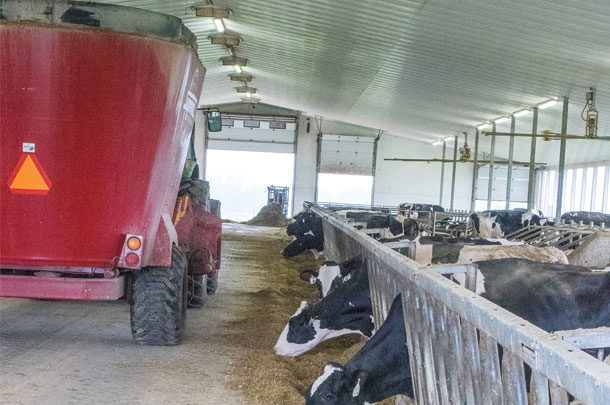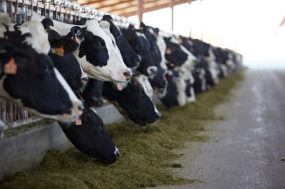The last few winter seasons we’ve experienced have not been easy for grasslands. Winters dotted with ice, followed by a dry summer, often led to the death or significant decrease in forage yields across the country.
Producers have been positive in front of this challenge and have been able to face the reality. However, “dealing with it” does not mean working without consequence for the months to come. When faced with decreased yields, several questions arise: Should I buy forages? Do I have to sow emergency forages? How should I adjust my feed management? etc.
Whatever the feed system, from the total mixed ration (TMR) to the pasture, high-quality forages are essential to produce high levels of milk and components while preserving the health of the dairy cow. Two main challenges faced when working with forages include:
1. Availability of inventories
2. Variability in quality
Dietary changes are generally a source of stress for animals. A modification of forage often rhymes with disruption of the microbial flora in the rumen.
Microorganisms play several roles essential to the proper functioning of the digestive system. When these functions are altered, the digestibility of food is undoubtedly reduced. Thus, nutritional strategies that will limit the damage are essential.
Among the tools available to minimize digestive damage, probiotics and prebiotics can have a prominent place in nutritional strategies. Let’s start by differentiating these two technical terms.
A prebiotic is defined as a non-living feed ingredient derived from selective fermentation, which advantageously affects the host by stimulating growth and activity of beneficial microbiota, thereby improving the health of the host. By supplying nutrients to the microflora, the prebiotic generates an increase in the contact surface and creates greater enzymatic activity in the rumen.
For their part, probiotics are a preparation or product containing viable microorganisms, defined in sufficient number, which modify the microbial flora (by implantation or colonization) in a compartment of the host, such as the rumen. The probiotic thus exerts beneficial effects on the animal’s health.
Unlike prebiotics, probiotics are sensitive to environmental conditions and have a short shelf life. Probiotics, heat, acidity and humidity do not mix well. However, the two tools can work together synergistically.
Optimizing ruminal functions in order to maximize the supply of energy (total volatile fatty acids [VFAs] and metabolizable energy) and proteins (microbial and metabolizable) to the dairy cow is normally a paying technique.
Digestibility determines the proportion of nutrients used by the animal for growth, reproduction, gestation, etc. The essential nutrients in the form of energy, proteins, minerals, vitamins and water (superior to those necessary for maintenance of normal bodily functions) must not only be supplied to the animal but also digested, if we expect the animal to optimize its performance. The challenge is therefore to support the rumen in the adaptation of microorganisms when there is variability in the quality of forages.
In lactating cows, the rate of passage is normally quite fast – between 6% and 8% per hour. When the rate of passage accelerates, the digestibility and absorption of nutrients are considerably reduced. There are two strategies to maximize the availability of nutrients in the rumen:
1. Reduce the passage rate: This strategy is not favourable because it may negatively affect dry matter intake (DMI), which is not normally the objective.
2. Increase the rate of degradation: This strategy is to be prioritized. It will generate a faster release of nutrients for the rumen – independent of DMI – and is controlled by many factors, such as the physical filling and the need of energy.
Once DMI is well controlled and digestibility is maximized, what about the absorption of nutrients? Absorption is defined by the movement of molecules through the gastrointestinal (GI) tract in the circulatory system. Most nutrients from the digestion process, such as vitamins, minerals and water, are absorbed into the lumen of the small intestine by four main absorption mechanisms:
- Active transport
- Passive transport
- Endocytosis
- Facilitated diffusion
To maximize performance, absorption processes should not be overlooked. For example, prebiotics, such as those derived from the fermentation of Aspergillus oryzae, have been shown to have the ability to increase passive transport of nutrients. Passive transport is mainly responsible for the displacement of macro elements as well as water. Unlike active transportation, passive transportation is not limited and does not require energy to function properly.
In addition to carefully working in the fields and making the right choices of forage species, the feeding strategies implemented must optimize DMI and maximize digestibility and the absorption of nutrients to limit the impacts of variability in the quality of forages. This will ultimately maximize the performance and revenue of the business over time. ![]()
PHOTO: With weather variations throughout the year, it is important to feed a high-quality TMR to keep the cows healthy and productive. Probiotics and prebiotics are two ways to help maintain optimal nutrition. Photo by Mike Dixon

-
Gabrielle Dumas
- Technical Representative
- DCL Nutrition and Animal Heath
- Email Gabrielle Dumas










